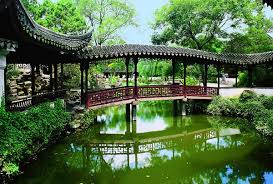Symbolism in Chinese Gardens and Space Design
For those who learn Mandarin online like engaging with an online Chinese teacher, understanding the cultural vocabulary behind traditional spaces can greatly enhance comprehension. Classical Chinese gardens are carefully constructed narratives where rocks, water, plants, and pathways carry philosophical and symbolic significance. You may have seen such a garden in your home country, but it is a total different thing in China and a feeling much more authentic. Language describing these elements—terms like “假山” (jiǎshān, artificial rockery), “廊桥” (lángqiáo, covered bridge), and “曲径通幽” (qūjìng tōng yōu, winding path to a secluded spot)—reflects centuries of aesthetic and intellectual thought.
Chinese gardens, particularly in regions like Suzhou, were historically designed to embody Daoist and Confucian ideals. Rocks symbolize mountains and stability, water represents flow and adaptability, and plantings often convey moral or emotional qualities—plum blossoms for perseverance, bamboo for integrity, and lotus for purity. Pathways and viewing corridors are deliberately arranged to reveal vistas sequentially, creating a dynamic dialogue between observer and environment. This careful orchestration is mirrored in the language used to describe gardens, where descriptive terms carry not only physical but also symbolic and philosophical weight.
The interplay between natural form and human design extended to private residences, scholarly retreats, and imperial spaces. Garden architecture also reflects hierarchy and status: the placement of structures, ponds, and pavilions communicates both social position and cultural literacy. Modern architects in China continue to draw inspiration from these principles, blending traditional motifs with contemporary materials, demonstrating the enduring relevance of these symbolic concepts.
Language institutions such as GoEast Mandarin provide learners with the opportunity to explore such cultural contexts alongside language study. There are often round trips to Chinese gardens, and teaching online, vocabulary related to architecture may also be introduced and there are virtual trips! This approach allows you to understand the worldview the vocabulary represent.
Classical Chinese gardens exemplify the integration of art, philosophy, and language. Through the study of spatial design and its descriptive terminology, you gain insight into how the Chinese conceptualize harmony, beauty, and moral order, appreciating language as a living reflection of cultural values!
read more : https://bistrovista.com/







